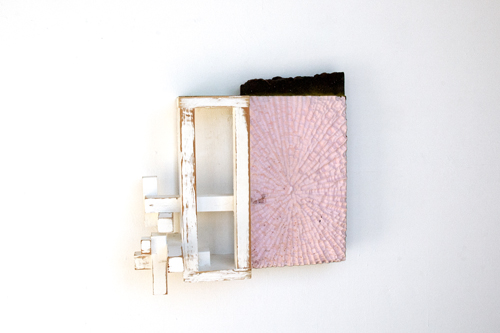Challenging assumptions about figure and ground, nature and industry, Robert Ortbal’s “Hide and Seek” reveals the instincts of a scientist exploring quirky bits of flotsam that speak to our human condition. Ortbal’s hybrid constructions mesh organic and man-made materials in playful, yet at times severely formal compositions, his wall-mounted and free-standing constructions suggesting objects which have sprouted or nucleated, like crystals, from the supporting framework.
Into and out of (2013) plays with the idea of an architectural element gone awry—a slender strip of paper, upon which two bands of steel lie, spans the wall from near-ceiling to near-floor, echoing the metal wall cap nearby. The strip becomes animated, writhing as the bands part like a zipper and the strips morph into snaky, coiling kinks, the lower form reverting to a calm wholeness before climbing partway back up the wall. Number 63 (2013), a drawing mounted on a chunk of plywood, hangs low, adjacent to the sculpture. A fuzzy, dark oval of airbrushed flocking hovers above a tower of simply sketched ovals of graduated scale.
If Ortbal’s earlier work had at times a manic quality, with elements like whirling arms splaying off in many directions, or linear cuts deeply gouging a wall, here the artist has retrenched, presenting a leaner and cleaner look. Part of this minimal aesthetic relates to inclusion of a new series of drawings inflected with a spare aesthetic akin to that of Richard Tuttle. Ortbal’s drawings suggest scientific diagrams or botanical illustrations—but for some cosmos or biology which is alien to our world. These unusual, reductive works are, in fact, a big departure for Ortbal, who has never included drawing as part of his mature art process. Simple, basic geometric forms—rectangle, sphere, oval, cone—are repeated in the deceptively empty drawings, forging a relationship with the more voluptuous sculptures.
Other Side of Patagonia (2013) in yellow, orange, black, white and rust evokes a crusty 3D jigsaw inspired by maps of South America. An adjacent drawing, Number 61 (2013), compresses hexagons in the same hues into a mass, spiky rays extending off into a fields of hatch marks, suggesting a honeycomb structure or molecular diagram. Throughout, nature and science collude and collide, aiming for a fortunate intersection. Ortbal poses questions about our knowledge of the world around us, and how perception shapes experience.
Beyond the Field (2012) juxtaposes a soft-looking pink rectangular mass, where a cruciform composition anchors radiating, deeply incised grooves, with an architectural construction of lengths of lumber brushed roughly with white paint. A sparkly band of black, like a mountain range, sits atop the pink, the cotton-candy hue a foil for the unusual coloring, punched up as a thin band of yellow-green flocking hugs the seam.
Ortbal invites the viewer to observe space from a thoughtful, quiet perspective. There is much to admire in the crafting of his work, in the variety of surfaces and materials, but it is the way in which his structures engage the empty space, suggesting the macrocosm and the microcosm, which conveys a pulsing sensation of energy within the emptiness.


